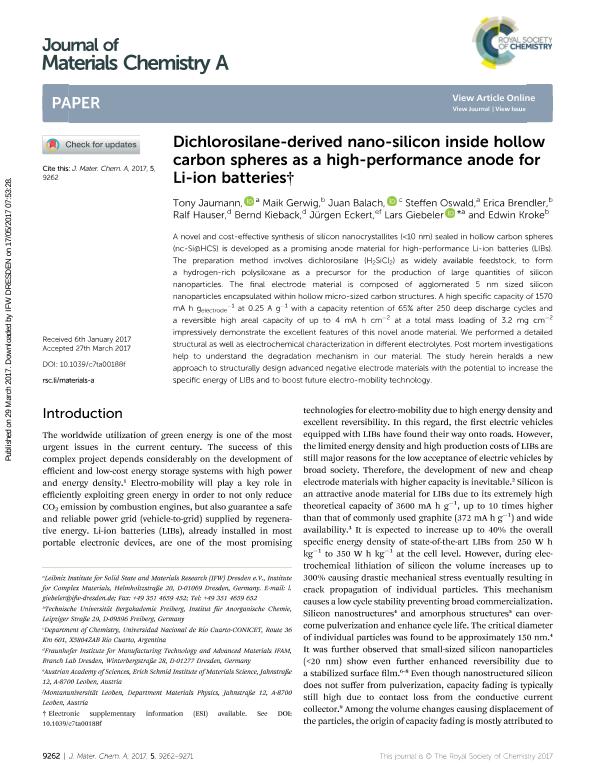Artículo
Dichlorosilane-derived nano-silicon inside hollow carbon spheres as a high-performance anode for Li-ion batteries
Jaumann, Tony; Gerwig, Maik; Balach, Juan Manuel ; Oswald, Steffen; Brendler, Erica; Hauser, Ralf; Kieback, Bernd; Eckert, Jürgen; Giebeler, Lars; Kroke, Edwin
; Oswald, Steffen; Brendler, Erica; Hauser, Ralf; Kieback, Bernd; Eckert, Jürgen; Giebeler, Lars; Kroke, Edwin
 ; Oswald, Steffen; Brendler, Erica; Hauser, Ralf; Kieback, Bernd; Eckert, Jürgen; Giebeler, Lars; Kroke, Edwin
; Oswald, Steffen; Brendler, Erica; Hauser, Ralf; Kieback, Bernd; Eckert, Jürgen; Giebeler, Lars; Kroke, Edwin
Fecha de publicación:
03/2017
Editorial:
Royal Society of Chemistry
Revista:
Journal of Materials Chemistry A
ISSN:
2050-7496
Idioma:
Inglés
Tipo de recurso:
Artículo publicado
Clasificación temática:
Resumen
A novel and cost-effective synthesis of silicon nanocrystallites (<10 nm) sealed in hollow carbon spheres (nc-Si@HCS) is developed as a promising anode material for high-performance Li-ion batteries (LIBs). The preparation method involves dichlorosilane (H2SiCl2) as widely available feedstock, to form a hydrogen-rich polysiloxane as a precursor for the production of large quantities of silicon nanoparticles. The final electrode material is composed of agglomerated 5 nm sized silicon nanoparticles encapsulated within hollow micro-sized carbon structures. A high specific capacity of 1570 mA h gelectrode-1 at 0.25 A g-1 with a capacity retention of 65% after 250 deep discharge cycles and a reversible high areal capacity of up to 4 mA h cm-2 at a total mass loading of 3.2 mg cm-2 impressively demonstrate the excellent features of this novel anode material. We performed a detailed structural as well as electrochemical characterization in different electrolytes. Post mortem investigations help to understand the degradation mechanism in our material. The study herein heralds a new approach to structurally design advanced negative electrode materials with the potential to increase the specific energy of LIBs and to boost future electro-mobility technology.
Palabras clave:
SILICON ANODE
,
HOLLOW CARBON SPHERES
,
HIGH PERFORMANCE
,
LI-ION BATTERY
Archivos asociados
Licencia
Identificadores
Colecciones
Articulos(CCT - CORDOBA)
Articulos de CTRO.CIENTIFICO TECNOL.CONICET - CORDOBA
Articulos de CTRO.CIENTIFICO TECNOL.CONICET - CORDOBA
Citación
Jaumann, Tony; Gerwig, Maik; Balach, Juan Manuel; Oswald, Steffen; Brendler, Erica; et al.; Dichlorosilane-derived nano-silicon inside hollow carbon spheres as a high-performance anode for Li-ion batteries; Royal Society of Chemistry; Journal of Materials Chemistry A; 5; 19; 3-2017; 9262-9271
Compartir
Altmétricas



